Business Law Report: Chia Ltd. Analysis of Legal Issues
VerifiedAdded on 2020/10/22
|11
|3506
|220
Report
AI Summary
This report examines key aspects of business law relevant to Chia Ltd., a hypothetical company. It begins by analyzing issues surrounding employment contracts, focusing on the legal requirements for written agreements and the implications of verbal contracts under the Employment Rights Act 1996. The report then delves into legal issues concerning equal pay, examining the Equality Act 2010 and the Equal Pay Act 1970 to address disparities in compensation among employees performing the same work. Finally, the report assesses the implications of working conditions under health and safety regulations, ensuring compliance and mitigating legal risks. The report concludes with a summary of the findings and recommendations for Chia Ltd. to ensure compliance with relevant laws and regulations, fostering a fair and safe working environment. The report emphasizes the importance of written contracts, equal pay for equal work, and adherence to health and safety standards to avoid legal repercussions and promote good business practices.
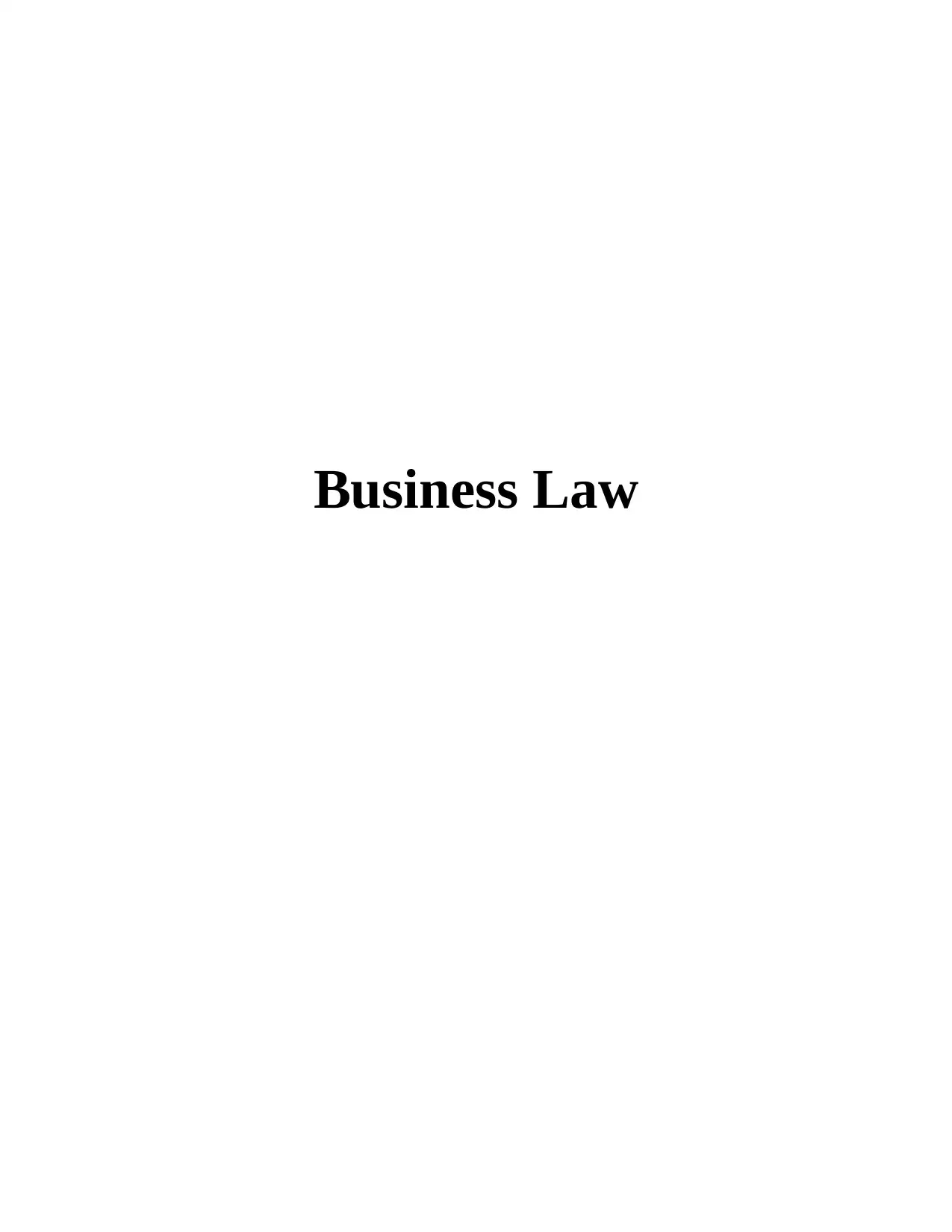
Business Law
Paraphrase This Document
Need a fresh take? Get an instant paraphrase of this document with our AI Paraphraser
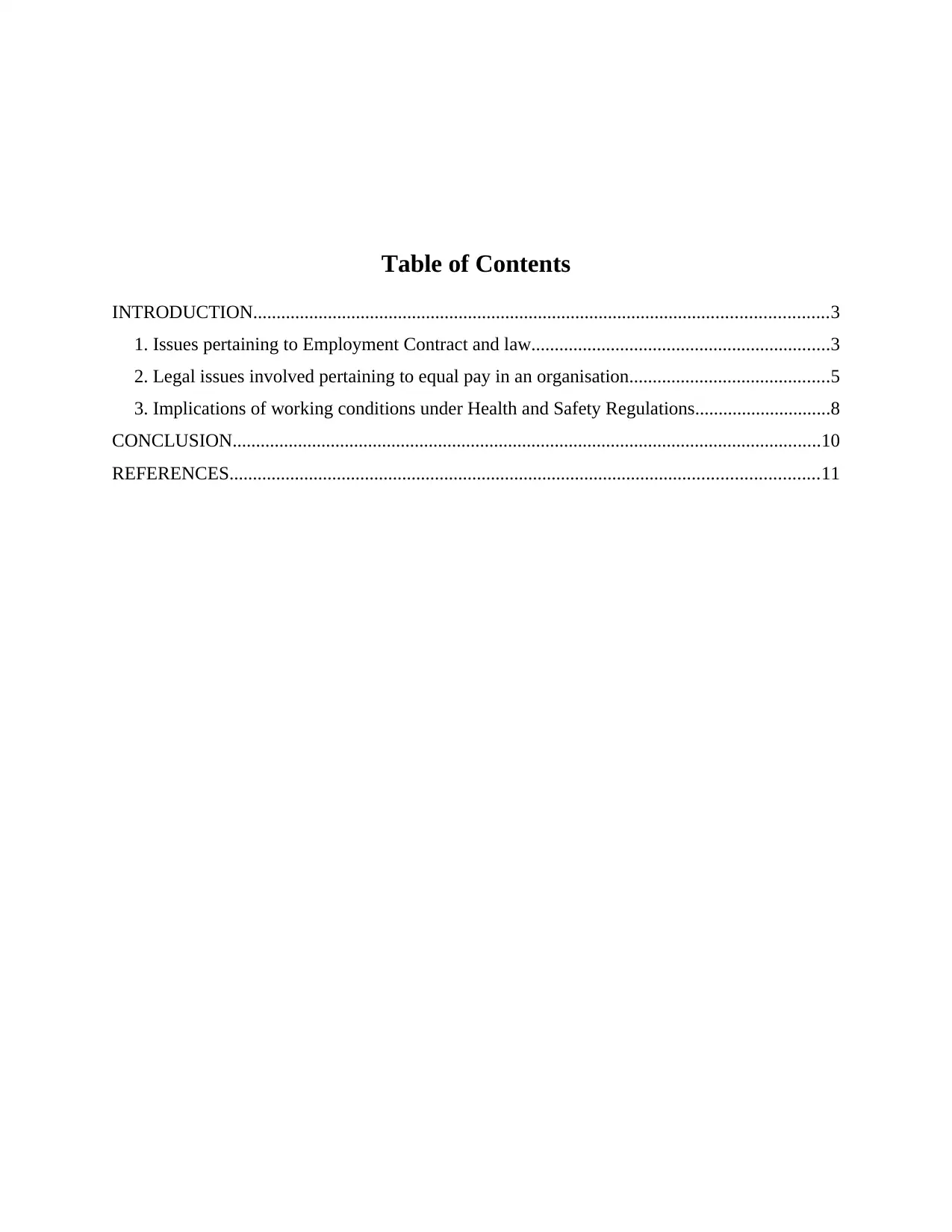
Table of Contents
INTRODUCTION...........................................................................................................................3
1. Issues pertaining to Employment Contract and law................................................................3
2. Legal issues involved pertaining to equal pay in an organisation...........................................5
3. Implications of working conditions under Health and Safety Regulations.............................8
CONCLUSION..............................................................................................................................10
REFERENCES..............................................................................................................................11
INTRODUCTION...........................................................................................................................3
1. Issues pertaining to Employment Contract and law................................................................3
2. Legal issues involved pertaining to equal pay in an organisation...........................................5
3. Implications of working conditions under Health and Safety Regulations.............................8
CONCLUSION..............................................................................................................................10
REFERENCES..............................................................................................................................11
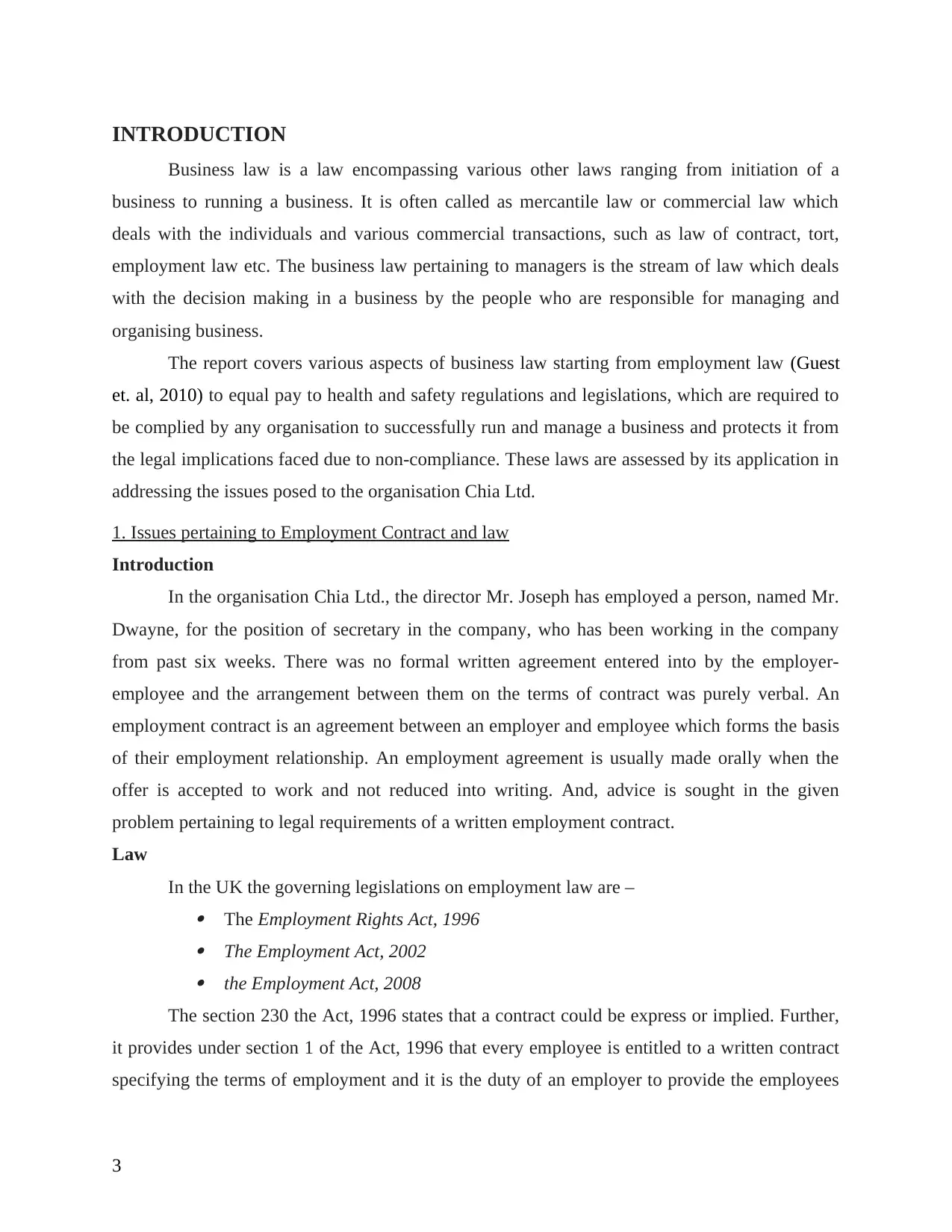
INTRODUCTION
Business law is a law encompassing various other laws ranging from initiation of a
business to running a business. It is often called as mercantile law or commercial law which
deals with the individuals and various commercial transactions, such as law of contract, tort,
employment law etc. The business law pertaining to managers is the stream of law which deals
with the decision making in a business by the people who are responsible for managing and
organising business.
The report covers various aspects of business law starting from employment law (Guest
et. al, 2010) to equal pay to health and safety regulations and legislations, which are required to
be complied by any organisation to successfully run and manage a business and protects it from
the legal implications faced due to non-compliance. These laws are assessed by its application in
addressing the issues posed to the organisation Chia Ltd.
1. Issues pertaining to Employment Contract and law
Introduction
In the organisation Chia Ltd., the director Mr. Joseph has employed a person, named Mr.
Dwayne, for the position of secretary in the company, who has been working in the company
from past six weeks. There was no formal written agreement entered into by the employer-
employee and the arrangement between them on the terms of contract was purely verbal. An
employment contract is an agreement between an employer and employee which forms the basis
of their employment relationship. An employment agreement is usually made orally when the
offer is accepted to work and not reduced into writing. And, advice is sought in the given
problem pertaining to legal requirements of a written employment contract.
Law
In the UK the governing legislations on employment law are –
The Employment Rights Act, 1996
The Employment Act, 2002
the Employment Act, 2008
The section 230 the Act, 1996 states that a contract could be express or implied. Further,
it provides under section 1 of the Act, 1996 that every employee is entitled to a written contract
specifying the terms of employment and it is the duty of an employer to provide the employees
3
Business law is a law encompassing various other laws ranging from initiation of a
business to running a business. It is often called as mercantile law or commercial law which
deals with the individuals and various commercial transactions, such as law of contract, tort,
employment law etc. The business law pertaining to managers is the stream of law which deals
with the decision making in a business by the people who are responsible for managing and
organising business.
The report covers various aspects of business law starting from employment law (Guest
et. al, 2010) to equal pay to health and safety regulations and legislations, which are required to
be complied by any organisation to successfully run and manage a business and protects it from
the legal implications faced due to non-compliance. These laws are assessed by its application in
addressing the issues posed to the organisation Chia Ltd.
1. Issues pertaining to Employment Contract and law
Introduction
In the organisation Chia Ltd., the director Mr. Joseph has employed a person, named Mr.
Dwayne, for the position of secretary in the company, who has been working in the company
from past six weeks. There was no formal written agreement entered into by the employer-
employee and the arrangement between them on the terms of contract was purely verbal. An
employment contract is an agreement between an employer and employee which forms the basis
of their employment relationship. An employment agreement is usually made orally when the
offer is accepted to work and not reduced into writing. And, advice is sought in the given
problem pertaining to legal requirements of a written employment contract.
Law
In the UK the governing legislations on employment law are –
The Employment Rights Act, 1996
The Employment Act, 2002
the Employment Act, 2008
The section 230 the Act, 1996 states that a contract could be express or implied. Further,
it provides under section 1 of the Act, 1996 that every employee is entitled to a written contract
specifying the terms of employment and it is the duty of an employer to provide the employees
3
⊘ This is a preview!⊘
Do you want full access?
Subscribe today to unlock all pages.

Trusted by 1+ million students worldwide
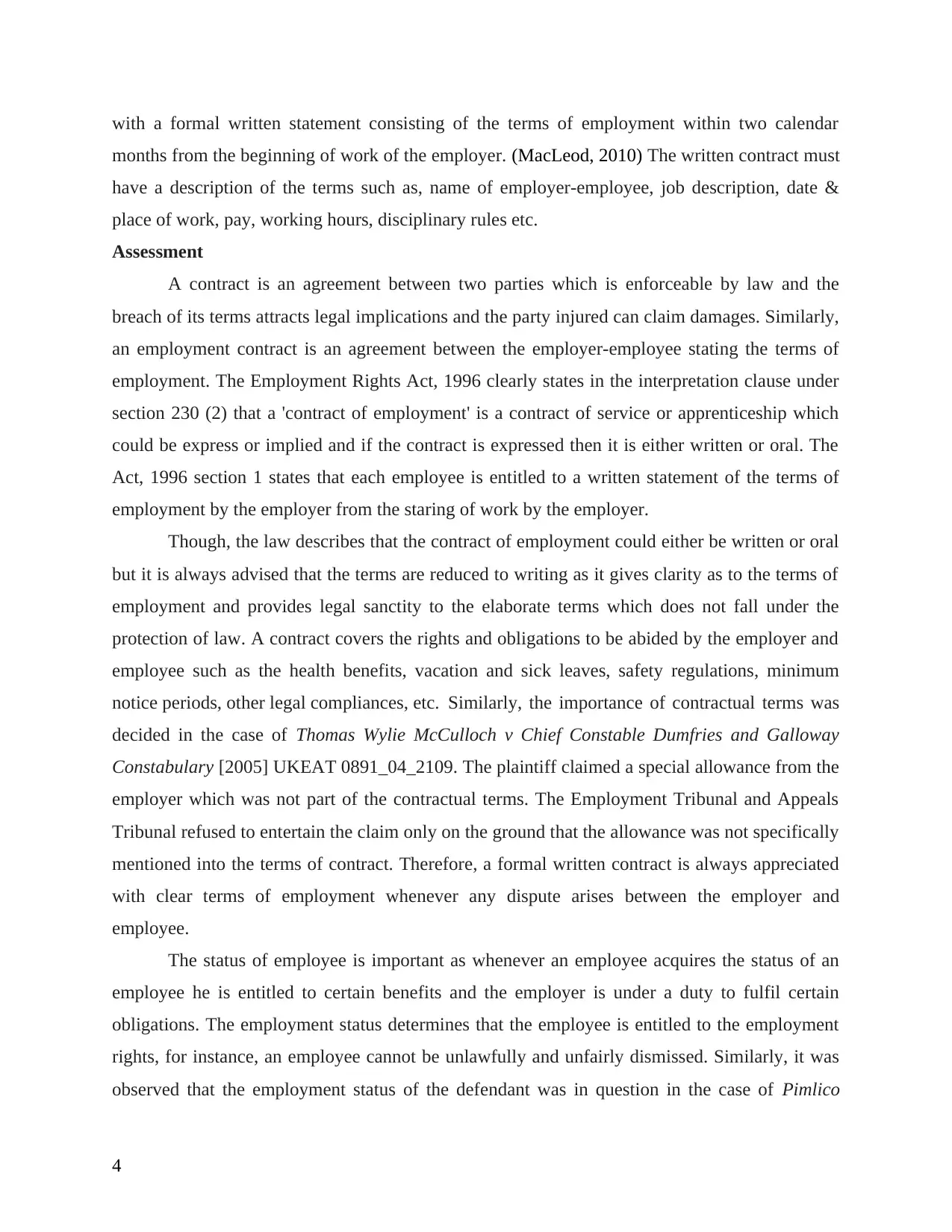
with a formal written statement consisting of the terms of employment within two calendar
months from the beginning of work of the employer. (MacLeod, 2010) The written contract must
have a description of the terms such as, name of employer-employee, job description, date &
place of work, pay, working hours, disciplinary rules etc.
Assessment
A contract is an agreement between two parties which is enforceable by law and the
breach of its terms attracts legal implications and the party injured can claim damages. Similarly,
an employment contract is an agreement between the employer-employee stating the terms of
employment. The Employment Rights Act, 1996 clearly states in the interpretation clause under
section 230 (2) that a 'contract of employment' is a contract of service or apprenticeship which
could be express or implied and if the contract is expressed then it is either written or oral. The
Act, 1996 section 1 states that each employee is entitled to a written statement of the terms of
employment by the employer from the staring of work by the employer.
Though, the law describes that the contract of employment could either be written or oral
but it is always advised that the terms are reduced to writing as it gives clarity as to the terms of
employment and provides legal sanctity to the elaborate terms which does not fall under the
protection of law. A contract covers the rights and obligations to be abided by the employer and
employee such as the health benefits, vacation and sick leaves, safety regulations, minimum
notice periods, other legal compliances, etc. Similarly, the importance of contractual terms was
decided in the case of Thomas Wylie McCulloch v Chief Constable Dumfries and Galloway
Constabulary [2005] UKEAT 0891_04_2109. The plaintiff claimed a special allowance from the
employer which was not part of the contractual terms. The Employment Tribunal and Appeals
Tribunal refused to entertain the claim only on the ground that the allowance was not specifically
mentioned into the terms of contract. Therefore, a formal written contract is always appreciated
with clear terms of employment whenever any dispute arises between the employer and
employee.
The status of employee is important as whenever an employee acquires the status of an
employee he is entitled to certain benefits and the employer is under a duty to fulfil certain
obligations. The employment status determines that the employee is entitled to the employment
rights, for instance, an employee cannot be unlawfully and unfairly dismissed. Similarly, it was
observed that the employment status of the defendant was in question in the case of Pimlico
4
months from the beginning of work of the employer. (MacLeod, 2010) The written contract must
have a description of the terms such as, name of employer-employee, job description, date &
place of work, pay, working hours, disciplinary rules etc.
Assessment
A contract is an agreement between two parties which is enforceable by law and the
breach of its terms attracts legal implications and the party injured can claim damages. Similarly,
an employment contract is an agreement between the employer-employee stating the terms of
employment. The Employment Rights Act, 1996 clearly states in the interpretation clause under
section 230 (2) that a 'contract of employment' is a contract of service or apprenticeship which
could be express or implied and if the contract is expressed then it is either written or oral. The
Act, 1996 section 1 states that each employee is entitled to a written statement of the terms of
employment by the employer from the staring of work by the employer.
Though, the law describes that the contract of employment could either be written or oral
but it is always advised that the terms are reduced to writing as it gives clarity as to the terms of
employment and provides legal sanctity to the elaborate terms which does not fall under the
protection of law. A contract covers the rights and obligations to be abided by the employer and
employee such as the health benefits, vacation and sick leaves, safety regulations, minimum
notice periods, other legal compliances, etc. Similarly, the importance of contractual terms was
decided in the case of Thomas Wylie McCulloch v Chief Constable Dumfries and Galloway
Constabulary [2005] UKEAT 0891_04_2109. The plaintiff claimed a special allowance from the
employer which was not part of the contractual terms. The Employment Tribunal and Appeals
Tribunal refused to entertain the claim only on the ground that the allowance was not specifically
mentioned into the terms of contract. Therefore, a formal written contract is always appreciated
with clear terms of employment whenever any dispute arises between the employer and
employee.
The status of employee is important as whenever an employee acquires the status of an
employee he is entitled to certain benefits and the employer is under a duty to fulfil certain
obligations. The employment status determines that the employee is entitled to the employment
rights, for instance, an employee cannot be unlawfully and unfairly dismissed. Similarly, it was
observed that the employment status of the defendant was in question in the case of Pimlico
4
Paraphrase This Document
Need a fresh take? Get an instant paraphrase of this document with our AI Paraphraser
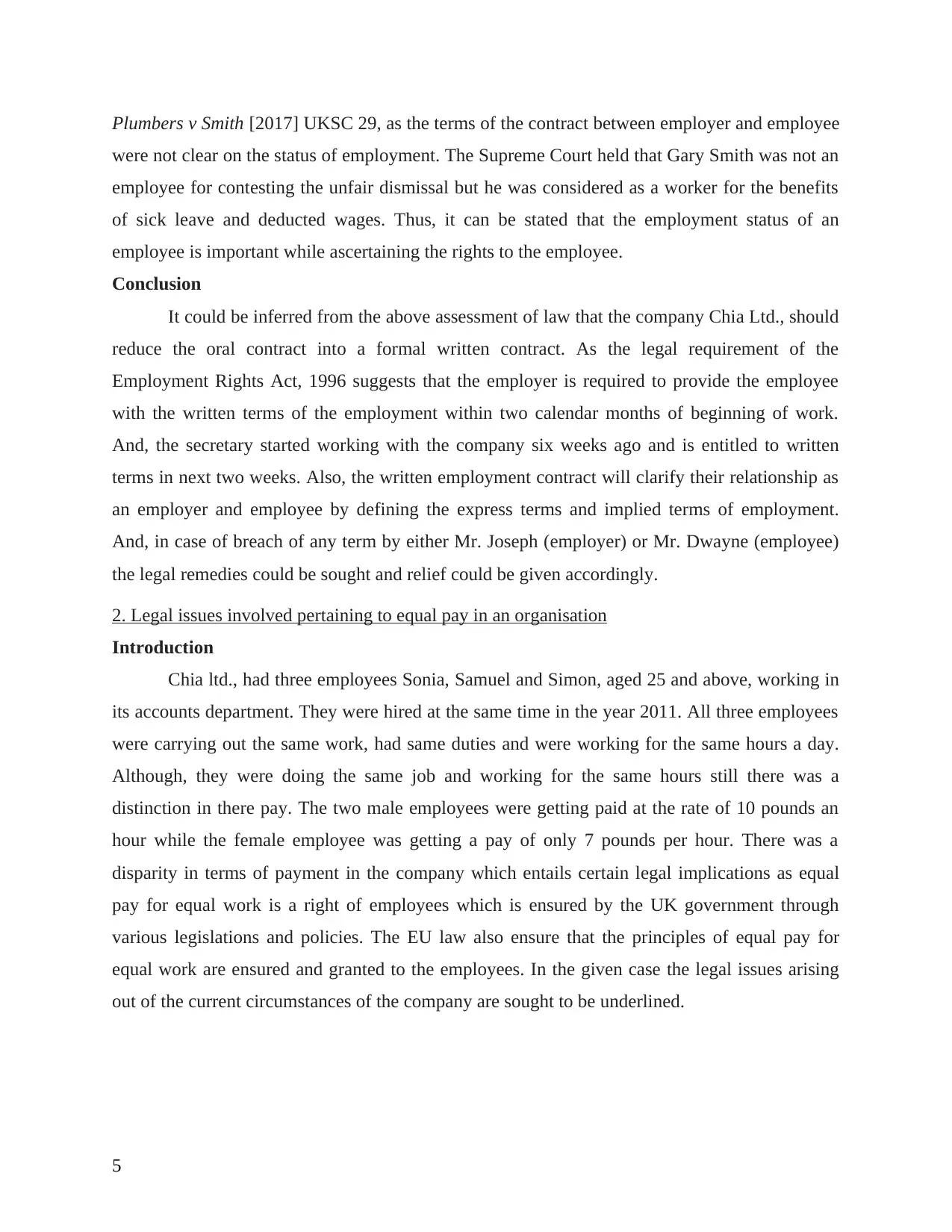
Plumbers v Smith [2017] UKSC 29, as the terms of the contract between employer and employee
were not clear on the status of employment. The Supreme Court held that Gary Smith was not an
employee for contesting the unfair dismissal but he was considered as a worker for the benefits
of sick leave and deducted wages. Thus, it can be stated that the employment status of an
employee is important while ascertaining the rights to the employee.
Conclusion
It could be inferred from the above assessment of law that the company Chia Ltd., should
reduce the oral contract into a formal written contract. As the legal requirement of the
Employment Rights Act, 1996 suggests that the employer is required to provide the employee
with the written terms of the employment within two calendar months of beginning of work.
And, the secretary started working with the company six weeks ago and is entitled to written
terms in next two weeks. Also, the written employment contract will clarify their relationship as
an employer and employee by defining the express terms and implied terms of employment.
And, in case of breach of any term by either Mr. Joseph (employer) or Mr. Dwayne (employee)
the legal remedies could be sought and relief could be given accordingly.
2. Legal issues involved pertaining to equal pay in an organisation
Introduction
Chia ltd., had three employees Sonia, Samuel and Simon, aged 25 and above, working in
its accounts department. They were hired at the same time in the year 2011. All three employees
were carrying out the same work, had same duties and were working for the same hours a day.
Although, they were doing the same job and working for the same hours still there was a
distinction in there pay. The two male employees were getting paid at the rate of 10 pounds an
hour while the female employee was getting a pay of only 7 pounds per hour. There was a
disparity in terms of payment in the company which entails certain legal implications as equal
pay for equal work is a right of employees which is ensured by the UK government through
various legislations and policies. The EU law also ensure that the principles of equal pay for
equal work are ensured and granted to the employees. In the given case the legal issues arising
out of the current circumstances of the company are sought to be underlined.
5
were not clear on the status of employment. The Supreme Court held that Gary Smith was not an
employee for contesting the unfair dismissal but he was considered as a worker for the benefits
of sick leave and deducted wages. Thus, it can be stated that the employment status of an
employee is important while ascertaining the rights to the employee.
Conclusion
It could be inferred from the above assessment of law that the company Chia Ltd., should
reduce the oral contract into a formal written contract. As the legal requirement of the
Employment Rights Act, 1996 suggests that the employer is required to provide the employee
with the written terms of the employment within two calendar months of beginning of work.
And, the secretary started working with the company six weeks ago and is entitled to written
terms in next two weeks. Also, the written employment contract will clarify their relationship as
an employer and employee by defining the express terms and implied terms of employment.
And, in case of breach of any term by either Mr. Joseph (employer) or Mr. Dwayne (employee)
the legal remedies could be sought and relief could be given accordingly.
2. Legal issues involved pertaining to equal pay in an organisation
Introduction
Chia ltd., had three employees Sonia, Samuel and Simon, aged 25 and above, working in
its accounts department. They were hired at the same time in the year 2011. All three employees
were carrying out the same work, had same duties and were working for the same hours a day.
Although, they were doing the same job and working for the same hours still there was a
distinction in there pay. The two male employees were getting paid at the rate of 10 pounds an
hour while the female employee was getting a pay of only 7 pounds per hour. There was a
disparity in terms of payment in the company which entails certain legal implications as equal
pay for equal work is a right of employees which is ensured by the UK government through
various legislations and policies. The EU law also ensure that the principles of equal pay for
equal work are ensured and granted to the employees. In the given case the legal issues arising
out of the current circumstances of the company are sought to be underlined.
5
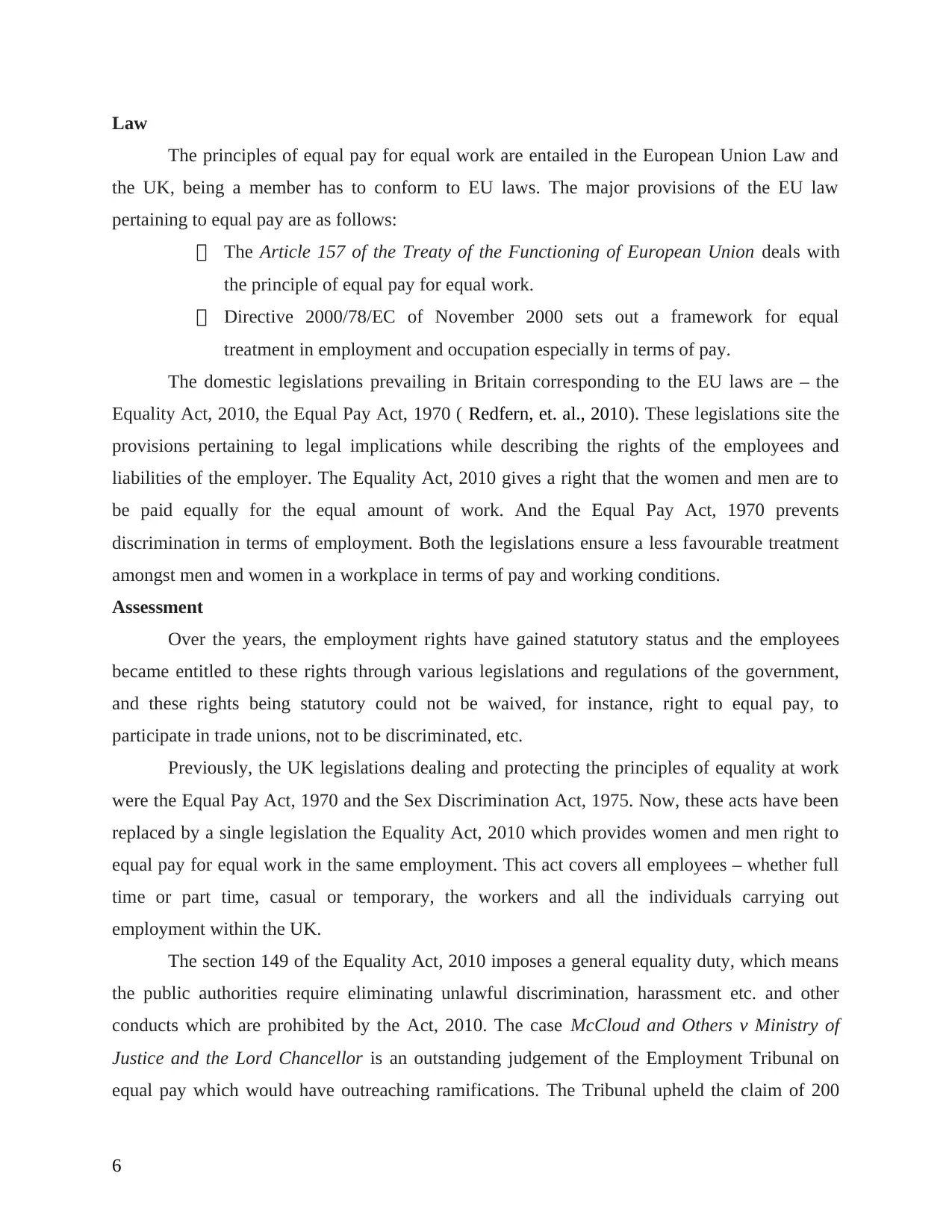
Law
The principles of equal pay for equal work are entailed in the European Union Law and
the UK, being a member has to conform to EU laws. The major provisions of the EU law
pertaining to equal pay are as follows:
The Article 157 of the Treaty of the Functioning of European Union deals with
the principle of equal pay for equal work.
Directive 2000/78/EC of November 2000 sets out a framework for equal
treatment in employment and occupation especially in terms of pay.
The domestic legislations prevailing in Britain corresponding to the EU laws are – the
Equality Act, 2010, the Equal Pay Act, 1970 ( Redfern, et. al., 2010). These legislations site the
provisions pertaining to legal implications while describing the rights of the employees and
liabilities of the employer. The Equality Act, 2010 gives a right that the women and men are to
be paid equally for the equal amount of work. And the Equal Pay Act, 1970 prevents
discrimination in terms of employment. Both the legislations ensure a less favourable treatment
amongst men and women in a workplace in terms of pay and working conditions.
Assessment
Over the years, the employment rights have gained statutory status and the employees
became entitled to these rights through various legislations and regulations of the government,
and these rights being statutory could not be waived, for instance, right to equal pay, to
participate in trade unions, not to be discriminated, etc.
Previously, the UK legislations dealing and protecting the principles of equality at work
were the Equal Pay Act, 1970 and the Sex Discrimination Act, 1975. Now, these acts have been
replaced by a single legislation the Equality Act, 2010 which provides women and men right to
equal pay for equal work in the same employment. This act covers all employees – whether full
time or part time, casual or temporary, the workers and all the individuals carrying out
employment within the UK.
The section 149 of the Equality Act, 2010 imposes a general equality duty, which means
the public authorities require eliminating unlawful discrimination, harassment etc. and other
conducts which are prohibited by the Act, 2010. The case McCloud and Others v Ministry of
Justice and the Lord Chancellor is an outstanding judgement of the Employment Tribunal on
equal pay which would have outreaching ramifications. The Tribunal upheld the claim of 200
6
The principles of equal pay for equal work are entailed in the European Union Law and
the UK, being a member has to conform to EU laws. The major provisions of the EU law
pertaining to equal pay are as follows:
The Article 157 of the Treaty of the Functioning of European Union deals with
the principle of equal pay for equal work.
Directive 2000/78/EC of November 2000 sets out a framework for equal
treatment in employment and occupation especially in terms of pay.
The domestic legislations prevailing in Britain corresponding to the EU laws are – the
Equality Act, 2010, the Equal Pay Act, 1970 ( Redfern, et. al., 2010). These legislations site the
provisions pertaining to legal implications while describing the rights of the employees and
liabilities of the employer. The Equality Act, 2010 gives a right that the women and men are to
be paid equally for the equal amount of work. And the Equal Pay Act, 1970 prevents
discrimination in terms of employment. Both the legislations ensure a less favourable treatment
amongst men and women in a workplace in terms of pay and working conditions.
Assessment
Over the years, the employment rights have gained statutory status and the employees
became entitled to these rights through various legislations and regulations of the government,
and these rights being statutory could not be waived, for instance, right to equal pay, to
participate in trade unions, not to be discriminated, etc.
Previously, the UK legislations dealing and protecting the principles of equality at work
were the Equal Pay Act, 1970 and the Sex Discrimination Act, 1975. Now, these acts have been
replaced by a single legislation the Equality Act, 2010 which provides women and men right to
equal pay for equal work in the same employment. This act covers all employees – whether full
time or part time, casual or temporary, the workers and all the individuals carrying out
employment within the UK.
The section 149 of the Equality Act, 2010 imposes a general equality duty, which means
the public authorities require eliminating unlawful discrimination, harassment etc. and other
conducts which are prohibited by the Act, 2010. The case McCloud and Others v Ministry of
Justice and the Lord Chancellor is an outstanding judgement of the Employment Tribunal on
equal pay which would have outreaching ramifications. The Tribunal upheld the claim of 200
6
⊘ This is a preview!⊘
Do you want full access?
Subscribe today to unlock all pages.

Trusted by 1+ million students worldwide
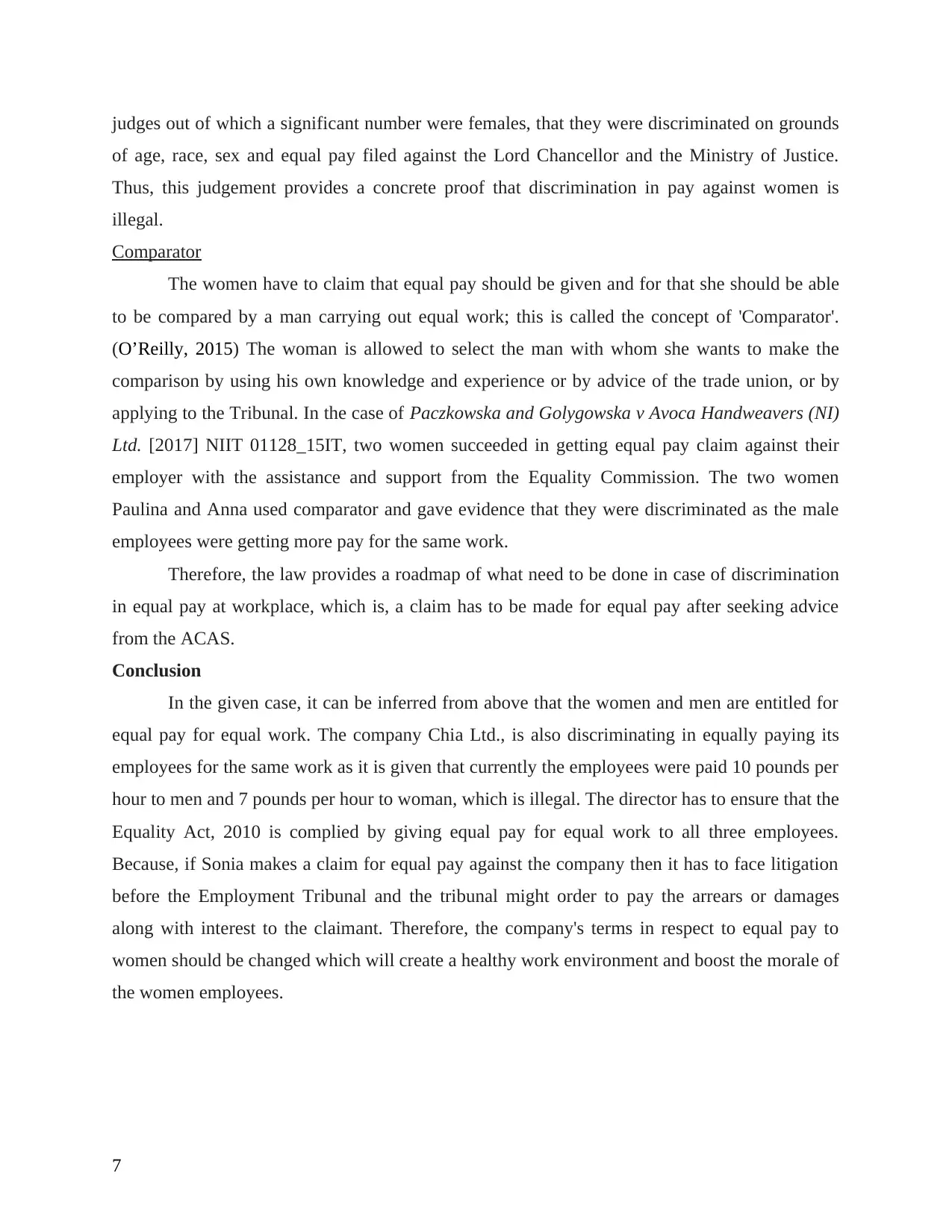
judges out of which a significant number were females, that they were discriminated on grounds
of age, race, sex and equal pay filed against the Lord Chancellor and the Ministry of Justice.
Thus, this judgement provides a concrete proof that discrimination in pay against women is
illegal.
Comparator
The women have to claim that equal pay should be given and for that she should be able
to be compared by a man carrying out equal work; this is called the concept of 'Comparator'.
(O’Reilly, 2015) The woman is allowed to select the man with whom she wants to make the
comparison by using his own knowledge and experience or by advice of the trade union, or by
applying to the Tribunal. In the case of Paczkowska and Golygowska v Avoca Handweavers (NI)
Ltd. [2017] NIIT 01128_15IT, two women succeeded in getting equal pay claim against their
employer with the assistance and support from the Equality Commission. The two women
Paulina and Anna used comparator and gave evidence that they were discriminated as the male
employees were getting more pay for the same work.
Therefore, the law provides a roadmap of what need to be done in case of discrimination
in equal pay at workplace, which is, a claim has to be made for equal pay after seeking advice
from the ACAS.
Conclusion
In the given case, it can be inferred from above that the women and men are entitled for
equal pay for equal work. The company Chia Ltd., is also discriminating in equally paying its
employees for the same work as it is given that currently the employees were paid 10 pounds per
hour to men and 7 pounds per hour to woman, which is illegal. The director has to ensure that the
Equality Act, 2010 is complied by giving equal pay for equal work to all three employees.
Because, if Sonia makes a claim for equal pay against the company then it has to face litigation
before the Employment Tribunal and the tribunal might order to pay the arrears or damages
along with interest to the claimant. Therefore, the company's terms in respect to equal pay to
women should be changed which will create a healthy work environment and boost the morale of
the women employees.
7
of age, race, sex and equal pay filed against the Lord Chancellor and the Ministry of Justice.
Thus, this judgement provides a concrete proof that discrimination in pay against women is
illegal.
Comparator
The women have to claim that equal pay should be given and for that she should be able
to be compared by a man carrying out equal work; this is called the concept of 'Comparator'.
(O’Reilly, 2015) The woman is allowed to select the man with whom she wants to make the
comparison by using his own knowledge and experience or by advice of the trade union, or by
applying to the Tribunal. In the case of Paczkowska and Golygowska v Avoca Handweavers (NI)
Ltd. [2017] NIIT 01128_15IT, two women succeeded in getting equal pay claim against their
employer with the assistance and support from the Equality Commission. The two women
Paulina and Anna used comparator and gave evidence that they were discriminated as the male
employees were getting more pay for the same work.
Therefore, the law provides a roadmap of what need to be done in case of discrimination
in equal pay at workplace, which is, a claim has to be made for equal pay after seeking advice
from the ACAS.
Conclusion
In the given case, it can be inferred from above that the women and men are entitled for
equal pay for equal work. The company Chia Ltd., is also discriminating in equally paying its
employees for the same work as it is given that currently the employees were paid 10 pounds per
hour to men and 7 pounds per hour to woman, which is illegal. The director has to ensure that the
Equality Act, 2010 is complied by giving equal pay for equal work to all three employees.
Because, if Sonia makes a claim for equal pay against the company then it has to face litigation
before the Employment Tribunal and the tribunal might order to pay the arrears or damages
along with interest to the claimant. Therefore, the company's terms in respect to equal pay to
women should be changed which will create a healthy work environment and boost the morale of
the women employees.
7
Paraphrase This Document
Need a fresh take? Get an instant paraphrase of this document with our AI Paraphraser
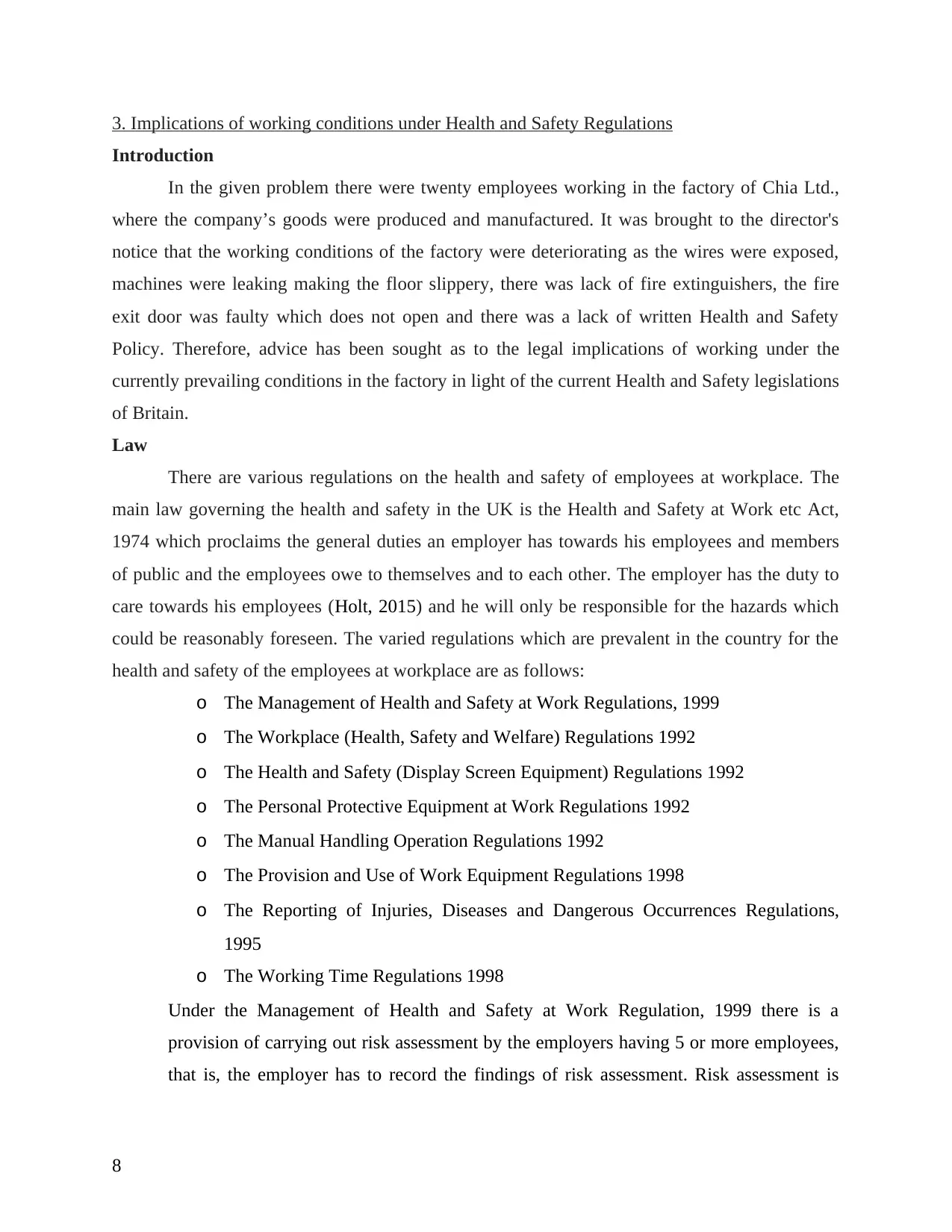
3. Implications of working conditions under Health and Safety Regulations
Introduction
In the given problem there were twenty employees working in the factory of Chia Ltd.,
where the company’s goods were produced and manufactured. It was brought to the director's
notice that the working conditions of the factory were deteriorating as the wires were exposed,
machines were leaking making the floor slippery, there was lack of fire extinguishers, the fire
exit door was faulty which does not open and there was a lack of written Health and Safety
Policy. Therefore, advice has been sought as to the legal implications of working under the
currently prevailing conditions in the factory in light of the current Health and Safety legislations
of Britain.
Law
There are various regulations on the health and safety of employees at workplace. The
main law governing the health and safety in the UK is the Health and Safety at Work etc Act,
1974 which proclaims the general duties an employer has towards his employees and members
of public and the employees owe to themselves and to each other. The employer has the duty to
care towards his employees (Holt, 2015) and he will only be responsible for the hazards which
could be reasonably foreseen. The varied regulations which are prevalent in the country for the
health and safety of the employees at workplace are as follows:
o The Management of Health and Safety at Work Regulations, 1999
o The Workplace (Health, Safety and Welfare) Regulations 1992
o The Health and Safety (Display Screen Equipment) Regulations 1992
o The Personal Protective Equipment at Work Regulations 1992
o The Manual Handling Operation Regulations 1992
o The Provision and Use of Work Equipment Regulations 1998
o The Reporting of Injuries, Diseases and Dangerous Occurrences Regulations,
1995
o The Working Time Regulations 1998
Under the Management of Health and Safety at Work Regulation, 1999 there is a
provision of carrying out risk assessment by the employers having 5 or more employees,
that is, the employer has to record the findings of risk assessment. Risk assessment is
8
Introduction
In the given problem there were twenty employees working in the factory of Chia Ltd.,
where the company’s goods were produced and manufactured. It was brought to the director's
notice that the working conditions of the factory were deteriorating as the wires were exposed,
machines were leaking making the floor slippery, there was lack of fire extinguishers, the fire
exit door was faulty which does not open and there was a lack of written Health and Safety
Policy. Therefore, advice has been sought as to the legal implications of working under the
currently prevailing conditions in the factory in light of the current Health and Safety legislations
of Britain.
Law
There are various regulations on the health and safety of employees at workplace. The
main law governing the health and safety in the UK is the Health and Safety at Work etc Act,
1974 which proclaims the general duties an employer has towards his employees and members
of public and the employees owe to themselves and to each other. The employer has the duty to
care towards his employees (Holt, 2015) and he will only be responsible for the hazards which
could be reasonably foreseen. The varied regulations which are prevalent in the country for the
health and safety of the employees at workplace are as follows:
o The Management of Health and Safety at Work Regulations, 1999
o The Workplace (Health, Safety and Welfare) Regulations 1992
o The Health and Safety (Display Screen Equipment) Regulations 1992
o The Personal Protective Equipment at Work Regulations 1992
o The Manual Handling Operation Regulations 1992
o The Provision and Use of Work Equipment Regulations 1998
o The Reporting of Injuries, Diseases and Dangerous Occurrences Regulations,
1995
o The Working Time Regulations 1998
Under the Management of Health and Safety at Work Regulation, 1999 there is a
provision of carrying out risk assessment by the employers having 5 or more employees,
that is, the employer has to record the findings of risk assessment. Risk assessment is
8
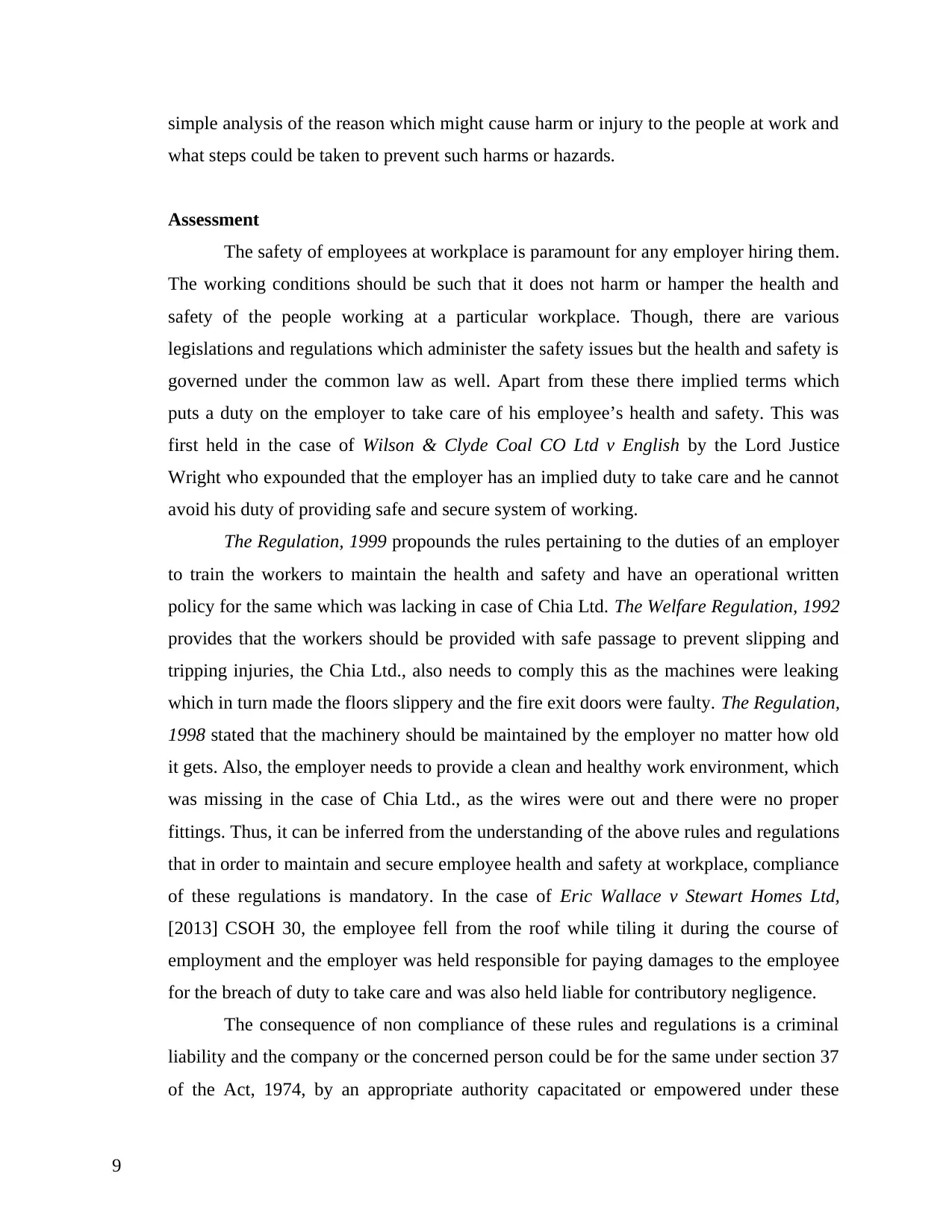
simple analysis of the reason which might cause harm or injury to the people at work and
what steps could be taken to prevent such harms or hazards.
Assessment
The safety of employees at workplace is paramount for any employer hiring them.
The working conditions should be such that it does not harm or hamper the health and
safety of the people working at a particular workplace. Though, there are various
legislations and regulations which administer the safety issues but the health and safety is
governed under the common law as well. Apart from these there implied terms which
puts a duty on the employer to take care of his employee’s health and safety. This was
first held in the case of Wilson & Clyde Coal CO Ltd v English by the Lord Justice
Wright who expounded that the employer has an implied duty to take care and he cannot
avoid his duty of providing safe and secure system of working.
The Regulation, 1999 propounds the rules pertaining to the duties of an employer
to train the workers to maintain the health and safety and have an operational written
policy for the same which was lacking in case of Chia Ltd. The Welfare Regulation, 1992
provides that the workers should be provided with safe passage to prevent slipping and
tripping injuries, the Chia Ltd., also needs to comply this as the machines were leaking
which in turn made the floors slippery and the fire exit doors were faulty. The Regulation,
1998 stated that the machinery should be maintained by the employer no matter how old
it gets. Also, the employer needs to provide a clean and healthy work environment, which
was missing in the case of Chia Ltd., as the wires were out and there were no proper
fittings. Thus, it can be inferred from the understanding of the above rules and regulations
that in order to maintain and secure employee health and safety at workplace, compliance
of these regulations is mandatory. In the case of Eric Wallace v Stewart Homes Ltd,
[2013] CSOH 30, the employee fell from the roof while tiling it during the course of
employment and the employer was held responsible for paying damages to the employee
for the breach of duty to take care and was also held liable for contributory negligence.
The consequence of non compliance of these rules and regulations is a criminal
liability and the company or the concerned person could be for the same under section 37
of the Act, 1974, by an appropriate authority capacitated or empowered under these
9
what steps could be taken to prevent such harms or hazards.
Assessment
The safety of employees at workplace is paramount for any employer hiring them.
The working conditions should be such that it does not harm or hamper the health and
safety of the people working at a particular workplace. Though, there are various
legislations and regulations which administer the safety issues but the health and safety is
governed under the common law as well. Apart from these there implied terms which
puts a duty on the employer to take care of his employee’s health and safety. This was
first held in the case of Wilson & Clyde Coal CO Ltd v English by the Lord Justice
Wright who expounded that the employer has an implied duty to take care and he cannot
avoid his duty of providing safe and secure system of working.
The Regulation, 1999 propounds the rules pertaining to the duties of an employer
to train the workers to maintain the health and safety and have an operational written
policy for the same which was lacking in case of Chia Ltd. The Welfare Regulation, 1992
provides that the workers should be provided with safe passage to prevent slipping and
tripping injuries, the Chia Ltd., also needs to comply this as the machines were leaking
which in turn made the floors slippery and the fire exit doors were faulty. The Regulation,
1998 stated that the machinery should be maintained by the employer no matter how old
it gets. Also, the employer needs to provide a clean and healthy work environment, which
was missing in the case of Chia Ltd., as the wires were out and there were no proper
fittings. Thus, it can be inferred from the understanding of the above rules and regulations
that in order to maintain and secure employee health and safety at workplace, compliance
of these regulations is mandatory. In the case of Eric Wallace v Stewart Homes Ltd,
[2013] CSOH 30, the employee fell from the roof while tiling it during the course of
employment and the employer was held responsible for paying damages to the employee
for the breach of duty to take care and was also held liable for contributory negligence.
The consequence of non compliance of these rules and regulations is a criminal
liability and the company or the concerned person could be for the same under section 37
of the Act, 1974, by an appropriate authority capacitated or empowered under these
9
⊘ This is a preview!⊘
Do you want full access?
Subscribe today to unlock all pages.

Trusted by 1+ million students worldwide
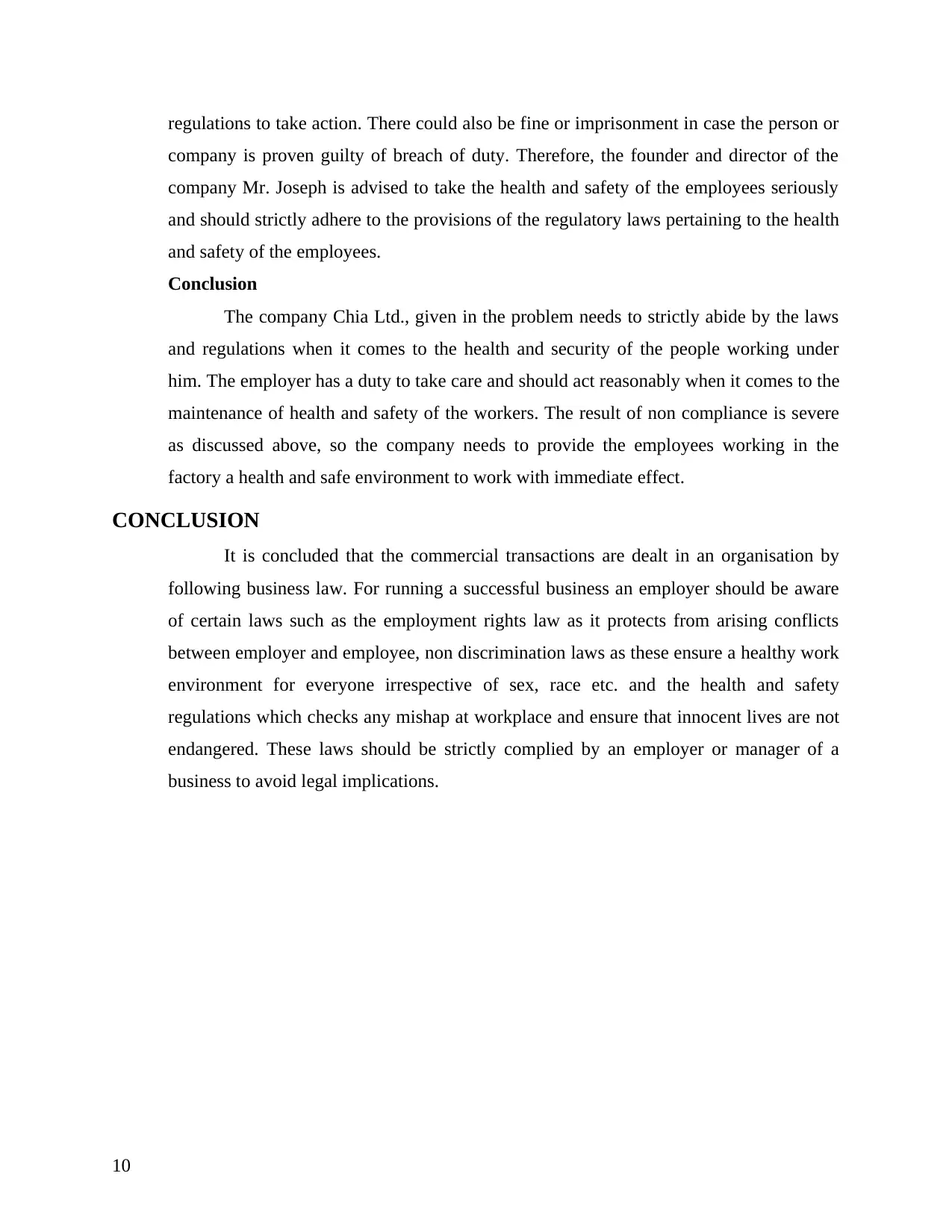
regulations to take action. There could also be fine or imprisonment in case the person or
company is proven guilty of breach of duty. Therefore, the founder and director of the
company Mr. Joseph is advised to take the health and safety of the employees seriously
and should strictly adhere to the provisions of the regulatory laws pertaining to the health
and safety of the employees.
Conclusion
The company Chia Ltd., given in the problem needs to strictly abide by the laws
and regulations when it comes to the health and security of the people working under
him. The employer has a duty to take care and should act reasonably when it comes to the
maintenance of health and safety of the workers. The result of non compliance is severe
as discussed above, so the company needs to provide the employees working in the
factory a health and safe environment to work with immediate effect.
CONCLUSION
It is concluded that the commercial transactions are dealt in an organisation by
following business law. For running a successful business an employer should be aware
of certain laws such as the employment rights law as it protects from arising conflicts
between employer and employee, non discrimination laws as these ensure a healthy work
environment for everyone irrespective of sex, race etc. and the health and safety
regulations which checks any mishap at workplace and ensure that innocent lives are not
endangered. These laws should be strictly complied by an employer or manager of a
business to avoid legal implications.
10
company is proven guilty of breach of duty. Therefore, the founder and director of the
company Mr. Joseph is advised to take the health and safety of the employees seriously
and should strictly adhere to the provisions of the regulatory laws pertaining to the health
and safety of the employees.
Conclusion
The company Chia Ltd., given in the problem needs to strictly abide by the laws
and regulations when it comes to the health and security of the people working under
him. The employer has a duty to take care and should act reasonably when it comes to the
maintenance of health and safety of the workers. The result of non compliance is severe
as discussed above, so the company needs to provide the employees working in the
factory a health and safe environment to work with immediate effect.
CONCLUSION
It is concluded that the commercial transactions are dealt in an organisation by
following business law. For running a successful business an employer should be aware
of certain laws such as the employment rights law as it protects from arising conflicts
between employer and employee, non discrimination laws as these ensure a healthy work
environment for everyone irrespective of sex, race etc. and the health and safety
regulations which checks any mishap at workplace and ensure that innocent lives are not
endangered. These laws should be strictly complied by an employer or manager of a
business to avoid legal implications.
10
Paraphrase This Document
Need a fresh take? Get an instant paraphrase of this document with our AI Paraphraser
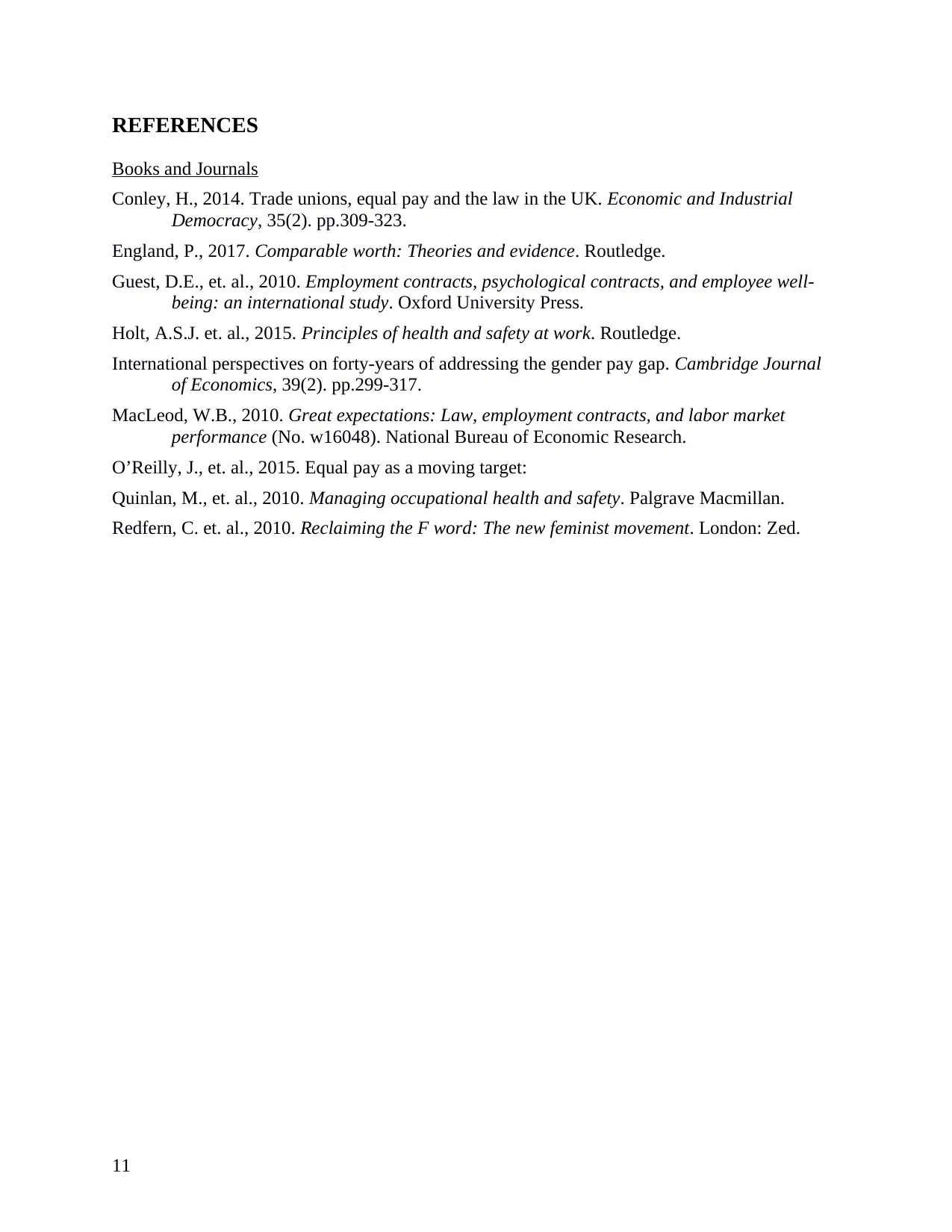
REFERENCES
Books and Journals
Conley, H., 2014. Trade unions, equal pay and the law in the UK. Economic and Industrial
Democracy, 35(2). pp.309-323.
England, P., 2017. Comparable worth: Theories and evidence. Routledge.
Guest, D.E., et. al., 2010. Employment contracts, psychological contracts, and employee well-
being: an international study. Oxford University Press.
Holt, A.S.J. et. al., 2015. Principles of health and safety at work. Routledge.
International perspectives on forty-years of addressing the gender pay gap. Cambridge Journal
of Economics, 39(2). pp.299-317.
MacLeod, W.B., 2010. Great expectations: Law, employment contracts, and labor market
performance (No. w16048). National Bureau of Economic Research.
O’Reilly, J., et. al., 2015. Equal pay as a moving target:
Quinlan, M., et. al., 2010. Managing occupational health and safety. Palgrave Macmillan.
Redfern, C. et. al., 2010. Reclaiming the F word: The new feminist movement. London: Zed.
11
Books and Journals
Conley, H., 2014. Trade unions, equal pay and the law in the UK. Economic and Industrial
Democracy, 35(2). pp.309-323.
England, P., 2017. Comparable worth: Theories and evidence. Routledge.
Guest, D.E., et. al., 2010. Employment contracts, psychological contracts, and employee well-
being: an international study. Oxford University Press.
Holt, A.S.J. et. al., 2015. Principles of health and safety at work. Routledge.
International perspectives on forty-years of addressing the gender pay gap. Cambridge Journal
of Economics, 39(2). pp.299-317.
MacLeod, W.B., 2010. Great expectations: Law, employment contracts, and labor market
performance (No. w16048). National Bureau of Economic Research.
O’Reilly, J., et. al., 2015. Equal pay as a moving target:
Quinlan, M., et. al., 2010. Managing occupational health and safety. Palgrave Macmillan.
Redfern, C. et. al., 2010. Reclaiming the F word: The new feminist movement. London: Zed.
11
1 out of 11
Related Documents
Your All-in-One AI-Powered Toolkit for Academic Success.
+13062052269
info@desklib.com
Available 24*7 on WhatsApp / Email
![[object Object]](/_next/static/media/star-bottom.7253800d.svg)
Unlock your academic potential
Copyright © 2020–2025 A2Z Services. All Rights Reserved. Developed and managed by ZUCOL.





